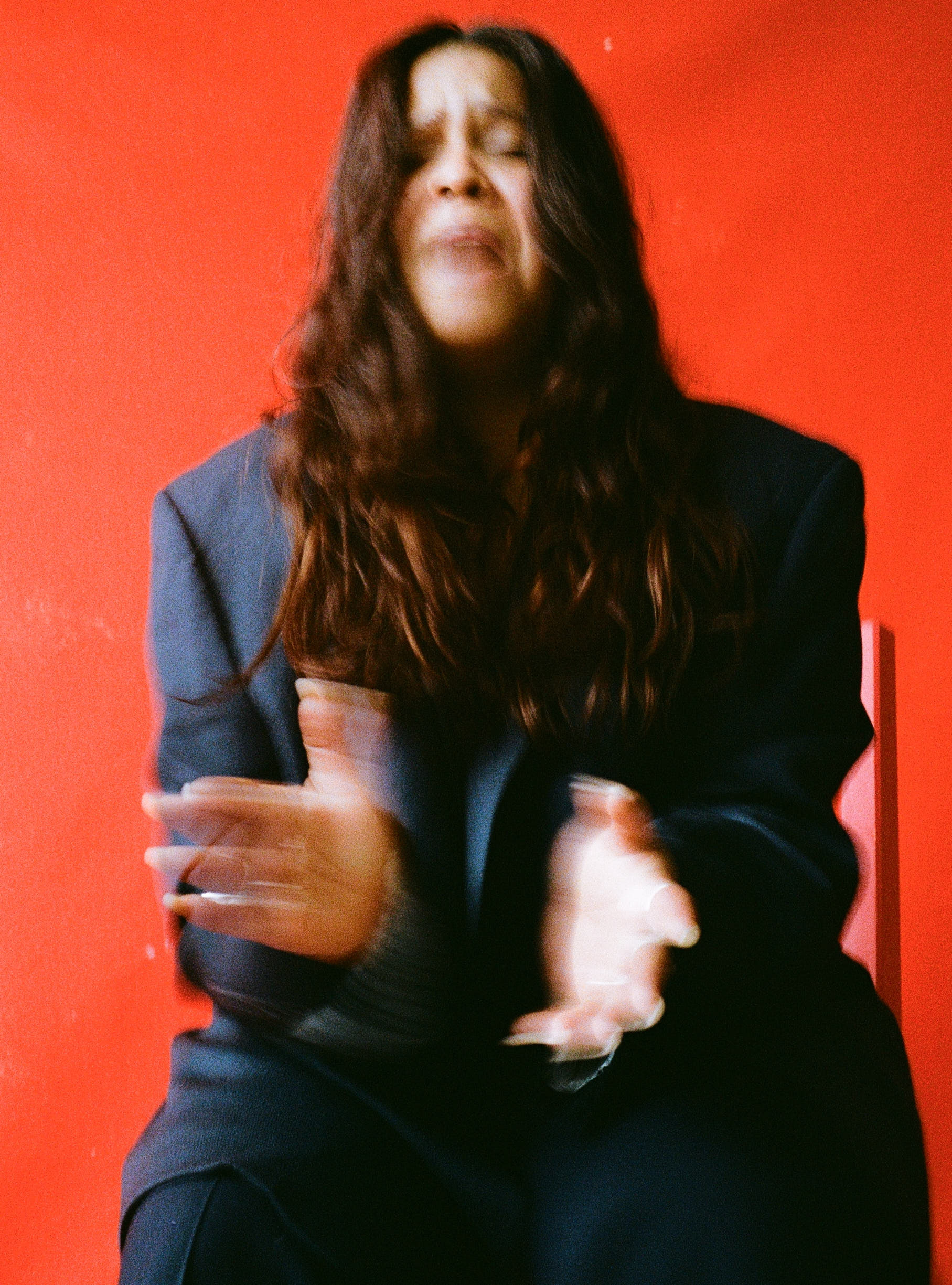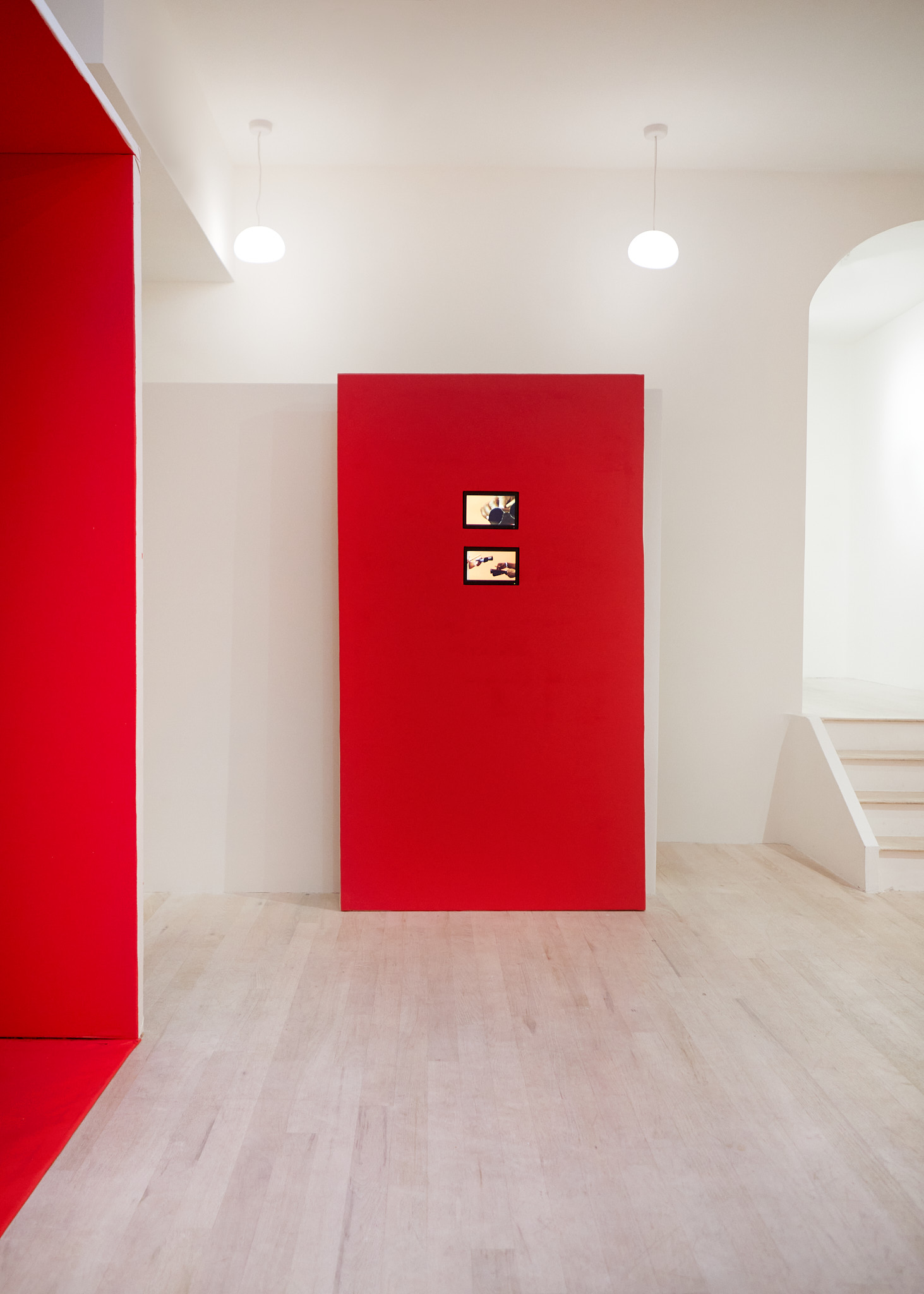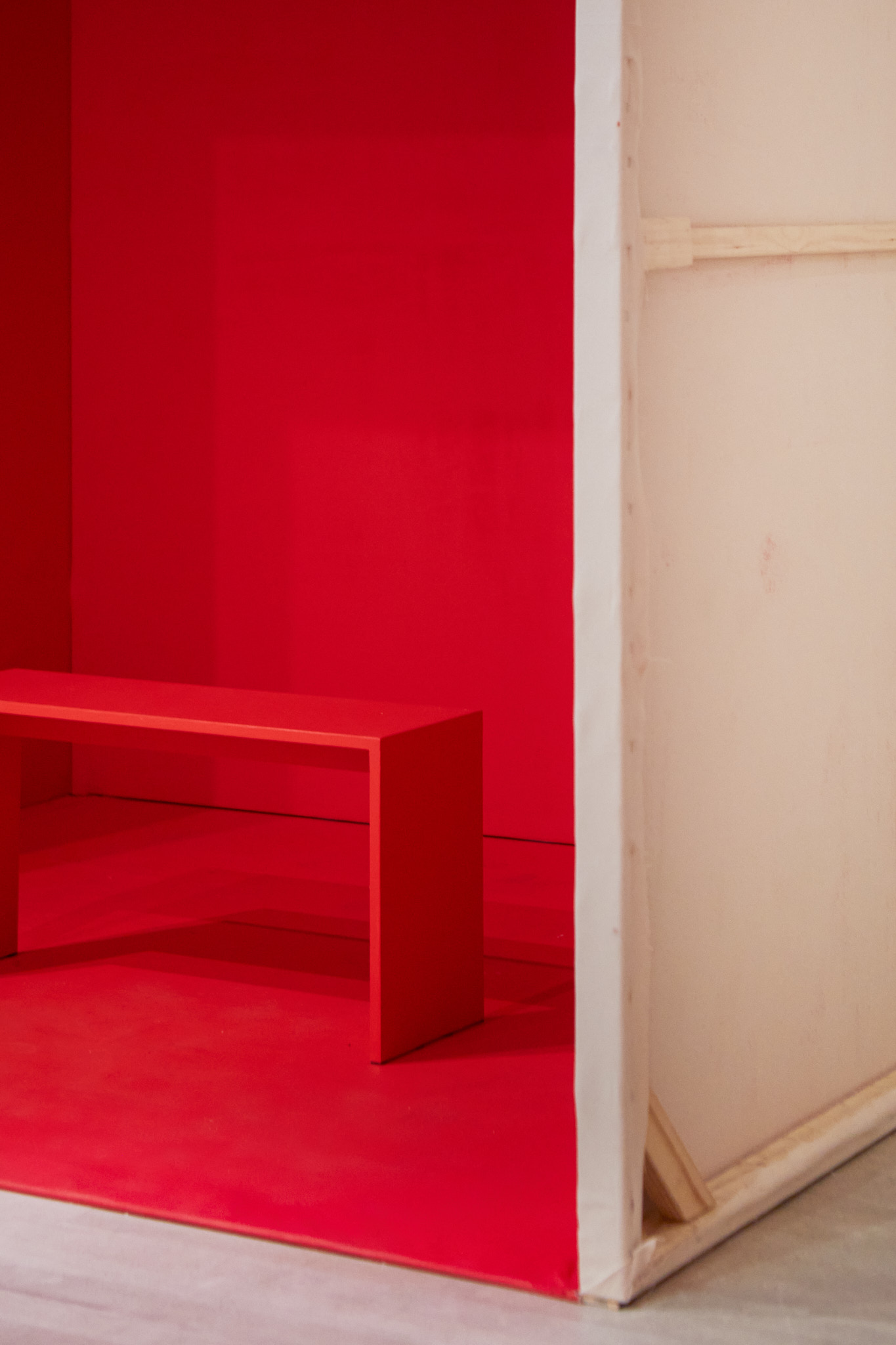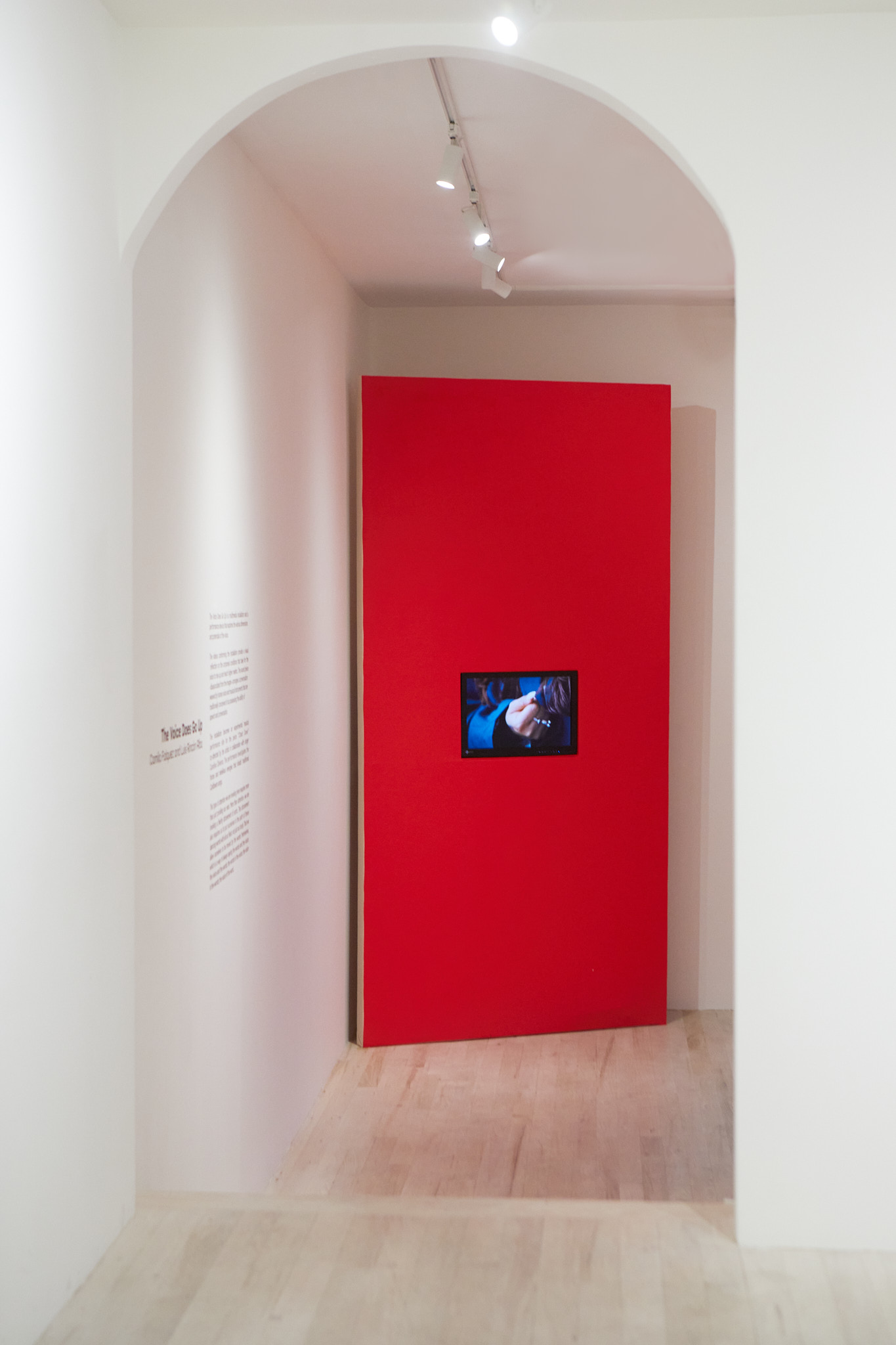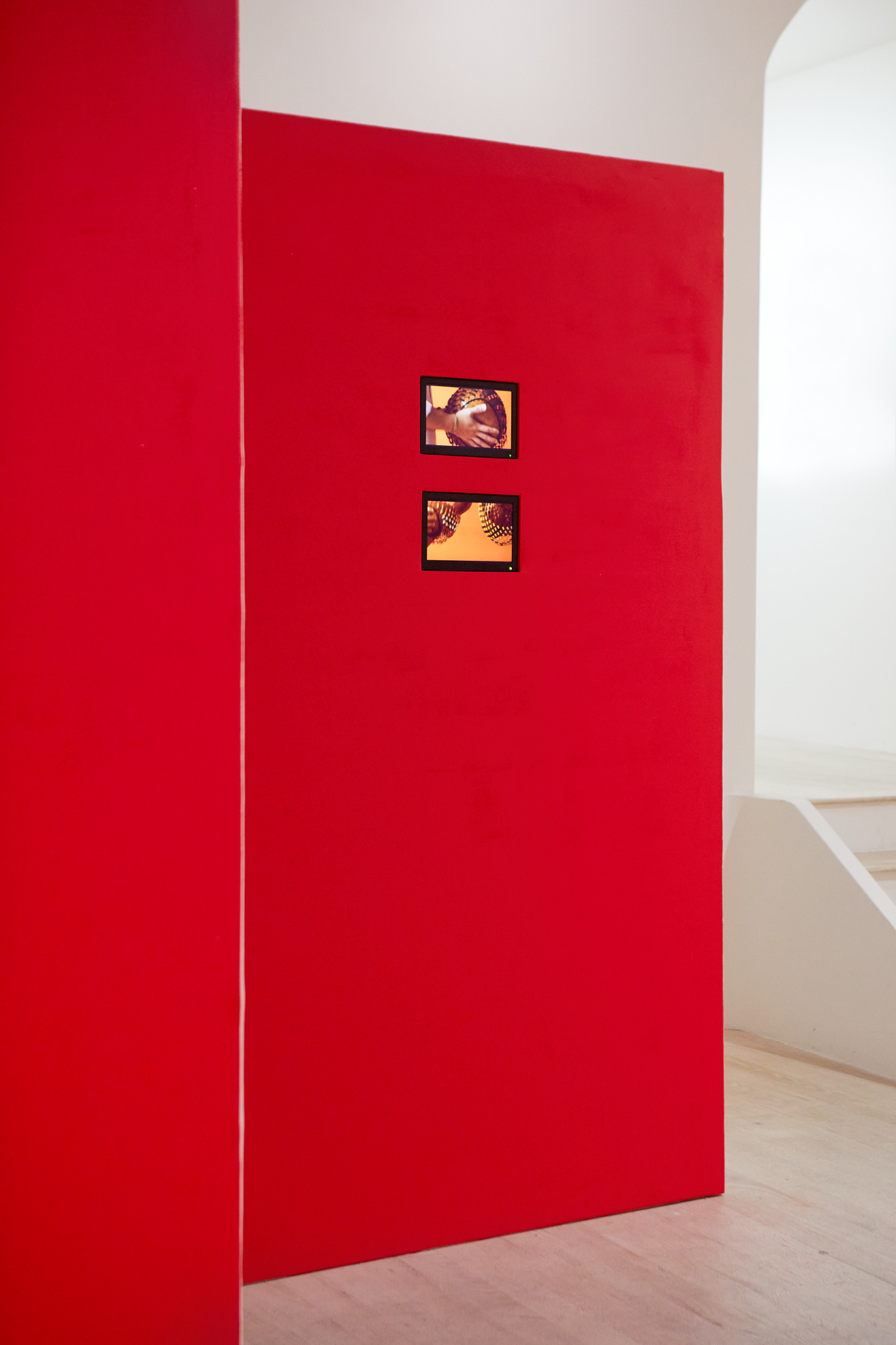
Hannah Traore Gallery is pleased to present The Voice Does Go Up, an exhibition by Camila Falquez and Luis Rincón Alba. The Voice Does Go Up is a multimedia installation and performance site that explores the various dimensions and potentials of the human voice. Activated through video, audio recording, and live performance, these scenarios feature collective assemblages of sound where the voice emerges through its gestural and material qualities. Emphasizing the role of the voice in music, the installation delves into and accentuates the most captivating and enchanting traits of sound. The exhibition’s title originates in a quote from the Saint Lucian poet and playwright Derek Walcott. In an interview with Edward Hirsch for The Paris Review in 1986 entitled “The Art of Poetry,” Walcott compared the task of the poet to that of the calypso singer, explaining “The voice does go up in a poem. It is an address, even if it is to oneself.”
The exhibition space is a monochromatic red environment featuring two tall panels onto which videos are embedded. The panels surround a performance device: a sparse plywood and canvas cube where the sound piece is played—a grounding structure within which the voice is amplified. Throughout the installation, captivating visual reflections emerge, offering insights into the physical conditions necessary for the voice to ascend. In addition to sound and video, Falquez and Rincón Alba will offer a series of specially designed performances within the installation space; these performances aim to further highlight the power and expressive range of the voice.
There are two types of videos in the exhibition, each offering unique perspectives. The first type comprises videos captured during fieldwork in Cuba and New Orleans, documenting vibrant religious and carnival celebrations where the charismatic power of the singing voice leads intimate gatherings. These videos provide viewers with the privilege of witnessing the bodily mastery required to channel specific vocal techniques that are believed to summon mystical forces. In contrast, the second type features studio-recorded video. Set within a controlled environment, these videos examine the intricate process behind producing such ascending voices. Singers and musicians hailing from the Caribbean diaspora and currently residing in New York, demonstrate how the body contorts, twists, and reshapes itself to achieve vocal strength. The central video features Colombian-born singer Carolina Oliveros.
The sound piece in the performance site offers a deeper reflection on the transcendent aspects of the voice, overcoming the ordinary relationship we have with our voices and exploring its transformative potential in individual and communal experience. As Rincón Alba expresses in the recording, “More than attention, we are invoking here a fleshly attunement of sorts. This attunement also requires us to put ourselves in the path of these dancing words with all our flesh, not just our body. That we allow ourselves to be moved by the words themselves, which is a way of always saying the words and the voice; the voice and the words; the words in the voice; the voice in the words; the voice of the word.”
The inaugural performance of the exhibition, debuting in September, will be Chant Down, featuring Oliveros as the lead voice. The piece investigates the forces and rebellious energies that inhabit traditional Caribbean songs, exploring the anticolonial legacies that gave shape to ancestral percussive and chanting techniques and the modes these legacies are reactivated through. Awakened by collective chanting, the performance seeks to access the vibrational registers—sometimes secret and hidden—in which the history of Black and Indigenous struggle found refuge.Through this assembly of video, sound, and performance, the exhibition transports visitors into a realm where music, spirituality, and the human body converge—illuminating the profound connection between physicality and vocal expression.
“Chant Down” Performance Series
the performance series that accompanies the installation “The Voice Does Go Up” investigates the forces and rebellious energies that inhabit traditional Caribbean songs and explores the anticolonial legacies that gave shape to ancestral percussive and chanting techniques. This performative exploration revisits the modes these legacies are reactivated through repetitive rhythmic and harmonic structures. Awakened by collective chanting, the performance seeks to access the vibrational registers—sometimes secret and hidden—in which the history of Black and Indigenous struggle found refuge. Spectators are invited into a performative listening session that make manifest the existence of highly complex musical and sonic structures in which anticolonial legacies have been codified and passed down to us.
This series has been developed in collaboration with Carolina Oliveros, an influential Colombian singer, composer, and researcher based in Brooklyn, NY. In “Chant Down” Carolina leads an experimental vocal and percussive ensemble that weaves multiple Caribbean and Latin American musical traditions that find a connective tissue, a rhythmic one, that brings together sonic traditions that have played a central role in the political history of the Americas. Chant Down seeks to rescue some of these sonic practices and recover them for a contemporary understanding of their value, relevance, and, above all, their political potential; in other words, their capacity to mobilize collective assemblies. The installation and the performance series, in harmonic conjunction, transport visitors into a realm where music, spirituality, and the human body converge.
Dates
Wednesday, September 13th at 7:30pm
Friday, September 22nd at 7:30 pm
Wednesday, September 27th 7:30 pm
Wednesday, October 4th 7:30 pm
Directed by
Camila Falquez, Luis Rincón Alba, and Carolina Oliveros.
Lead Voice
Carolina Oliveros
Performers
Natalia Perez
Gina Soto
Mobéy Lola Irizarry
Duration: 40 mins
Capacity: 12 spectators
Camila Falquez – Visual Director
Camila Falquez is a New York-based photographer and visual artist of Colombian heritage. She was born in Mexico City and grew up in Spain. Falquez’s photographs harness the traditions of fashion and portrait photography and honor the contemporary spectrum of social and gender diversity. Channeling the conventions of surrealism and a strong color palette, Falquez elevates and empowers her subjects. Her images have been published in The New York Times, TIME Magazine, El País, WSJ, and Vogue, among others. She has collaborated with brands such as Clinique, Hermes and Nike. In 2022, Falquez had her first solo exhibition in New York at Hannah Traore Gallery called Gods That Walk Among Us.
Carolina Oliveros – Musical Director
Carolina Oliveros: Musician, singer, composer, and researcher born in the city of Barranquilla, Colombia. Since 2014, shehas been residing in New York City, where she has been developing her professional career and also projecting her work and research in the Colombian Caribbean. In Colombia, she founded the group “Tonada” an important collective focused on bullerengue music. In NYC, she founded and currently directs “Bulla en el Barrio,” a bullerengue group composed of musicians from the diaspora. This group also serves as a way to research this ancestral musical genre from the diaspora perspective and within the Colombian territory.
Since 2016, she has been the lead vocalist of the psychedelic group “Combo Chimbita”, which is currently signed under ANTI Records. With this group, she has created an extensive, rich, and versatile body of musical work, including multiple albums, music videos, and successful international tours. As a performance artist, she has collaborated with Leimay Ensemble (NYC) in the piece “Extinction Rituals “which premiered this year during the Japan Society’ s season. Since 2022, she has also been collaborating with Luis Rincón Alba and Camila Falquez on performance proposals that explore the hidden potential of traditional chants.
Luis Rincón Alba – Performance Director
Luis Rincón Alba is a scholar and artist whose research focuses on the political and social potential of festive practices in the Caribbean and Latin America. He delves into the history of rebellion and insurrection during the colonial period and investigates how this history informs and shapes contemporary artistic practices. As an artist, Rincón Alba draws from historical materials and practices that he has encountered in his native Colombia and in his travels around the Caribbean and the Americas. He works across various mediums, including live performance, film, video, sound, and writing, to convey the unspoken lineages of rebellion that continue through festive practice. He is currently assistant professor at NYU’s Tisch School of the Arts in the Department of Art & Public Policy. His book project, Dance to the Hurt! Carnival Performance, Riots, and Festive Mutuality is a groundbreaking study that links the history of carnivals in the Caribbean with the riots that were critical to the end of slavery and colonial regimes. Luis Rincón Alba has received numerous fellowships and awards in recognition of his contributions to the humanities. He has been a fellow at NYU’s Center for the Humanities and the Urban Democracy Lab and has also received public humanities fellowships at Columbia University’s Center for the Study of Social Difference and Humanities New York. In 2010, he was awarded a prestigious Fulbright fellowship.
Hannah Traore Gallery is pleased to present The Voice Does Go Up, an exhibition by Camila Falquez and Luis Rincón Alba. The Voice Does Go Up is a multimedia installation and performance site that explores the various dimensions and potentials of the human voice. Activated through video, audio recording, and live performance, these scenarios feature collective assemblages of sound where the voice emerges through its gestural and material qualities. Emphasizing the role of the voice in music, the installation delves into and accentuates the most captivating and enchanting traits of sound. The exhibition’s title originates in a quote from the Saint Lucian poet and playwright Derek Walcott. In an interview with Edward Hirsch for The Paris Review in 1986 entitled “The Art of Poetry,” Walcott compared the task of the poet to that of the calypso singer, explaining “The voice does go up in a poem. It is an address, even if it is to oneself.”
The exhibition space is a monochromatic red environment featuring two tall panels onto which videos are embedded. The panels surround a performance device: a sparse plywood and canvas cube where the sound piece is played—a grounding structure within which the voice is amplified. Throughout the installation, captivating visual reflections emerge, offering insights into the physical conditions necessary for the voice to ascend. In addition to sound and video, Falquez and Rincón Alba will offer a series of specially designed performances within the installation space; these performances aim to further highlight the power and expressive range of the voice.
There are two types of videos in the exhibition, each offering unique perspectives. The first type comprises videos captured during fieldwork in Cuba and New Orleans, documenting vibrant religious and carnival celebrations where the charismatic power of the singing voice leads intimate gatherings. These videos provide viewers with the privilege of witnessing the bodily mastery required to channel specific vocal techniques that are believed to summon mystical forces. In contrast, the second type features studio-recorded video. Set within a controlled environment, these videos examine the intricate process behind producing such ascending voices. Singers and musicians hailing from the Caribbean diaspora and currently residing in New York, demonstrate how the body contorts, twists, and reshapes itself to achieve vocal strength. The central video features Colombian-born singer Carolina Oliveros.
The sound piece in the performance site offers a deeper reflection on the transcendent aspects of the voice, overcoming the ordinary relationship we have with our voices and exploring its transformative potential in individual and communal experience. As Rincón Alba expresses in the recording, “More than attention, we are invoking here a fleshly attunement of sorts. This attunement also requires us to put ourselves in the path of these dancing words with all our flesh, not just our body. That we allow ourselves to be moved by the words themselves, which is a way of always saying the words and the voice; the voice and the words; the words in the voice; the voice in the words; the voice of the word.”
The inaugural performance of the exhibition, debuting in September, will be Chant Down, featuring Oliveros as the lead voice. The piece investigates the forces and rebellious energies that inhabit traditional Caribbean songs, exploring the anticolonial legacies that gave shape to ancestral percussive and chanting techniques and the modes these legacies are reactivated through. Awakened by collective chanting, the performance seeks to access the vibrational registers—sometimes secret and hidden—in which the history of Black and Indigenous struggle found refuge.Through this assembly of video, sound, and performance, the exhibition transports visitors into a realm where music, spirituality, and the human body converge—illuminating the profound connection between physicality and vocal expression.
“Chant Down” Performance Series
the performance series that accompanies the installation “The Voice Does Go Up” investigates the forces and rebellious energies that inhabit traditional Caribbean songs and explores the anticolonial legacies that gave shape to ancestral percussive and chanting techniques. This performative exploration revisits the modes these legacies are reactivated through repetitive rhythmic and harmonic structures. Awakened by collective chanting, the performance seeks to access the vibrational registers—sometimes secret and hidden—in which the history of Black and Indigenous struggle found refuge. Spectators are invited into a performative listening session that make manifest the existence of highly complex musical and sonic structures in which anticolonial legacies have been codified and passed down to us.
This series has been developed in collaboration with Carolina Oliveros, an influential Colombian singer, composer, and researcher based in Brooklyn, NY. In “Chant Down” Carolina leads an experimental vocal and percussive ensemble that weaves multiple Caribbean and Latin American musical traditions that find a connective tissue, a rhythmic one, that brings together sonic traditions that have played a central role in the political history of the Americas. Chant Down seeks to rescue some of these sonic practices and recover them for a contemporary understanding of their value, relevance, and, above all, their political potential; in other words, their capacity to mobilize collective assemblies. The installation and the performance series, in harmonic conjunction, transport visitors into a realm where music, spirituality, and the human body converge.
Dates
Wednesday, September 13th at 7:30pm
Friday, September 22nd at 7:30 pm
Wednesday, September 27th 7:30 pm
Wednesday, October 4th 7:30 pm
Directed by
Camila Falquez, Luis Rincón Alba, and Carolina Oliveros.
Lead Voice
Carolina Oliveros
Performers
Natalia Perez
Gina Soto
Mobéy Lola Irizarry
Duration: 40 mins
Capacity: 12 spectators
Camila Falquez – Visual Director
Camila Falquez is a New York-based photographer and visual artist of Colombian heritage. She was born in Mexico City and grew up in Spain. Falquez’s photographs harness the traditions of fashion and portrait photography and honor the contemporary spectrum of social and gender diversity. Channeling the conventions of surrealism and a strong color palette, Falquez elevates and empowers her subjects. Her images have been published in The New York Times, TIME Magazine, El País, WSJ, and Vogue, among others. She has collaborated with brands such as Clinique, Hermes and Nike. In 2022, Falquez had her first solo exhibition in New York at Hannah Traore Gallery called Gods That Walk Among Us.
Carolina Oliveros – Musical Director
Carolina Oliveros: Musician, singer, composer, and researcher born in the city of Barranquilla, Colombia. Since 2014, shehas been residing in New York City, where she has been developing her professional career and also projecting her work and research in the Colombian Caribbean. In Colombia, she founded the group “Tonada” an important collective focused on bullerengue music. In NYC, she founded and currently directs “Bulla en el Barrio,” a bullerengue group composed of musicians from the diaspora. This group also serves as a way to research this ancestral musical genre from the diaspora perspective and within the Colombian territory.
Since 2016, she has been the lead vocalist of the psychedelic group “Combo Chimbita”, which is currently signed under ANTI Records. With this group, she has created an extensive, rich, and versatile body of musical work, including multiple albums, music videos, and successful international tours. As a performance artist, she has collaborated with Leimay Ensemble (NYC) in the piece “Extinction Rituals “which premiered this year during the Japan Society’ s season. Since 2022, she has also been collaborating with Luis Rincón Alba and Camila Falquez on performance proposals that explore the hidden potential of traditional chants.
Luis Rincón Alba – Performance Director
Luis Rincón Alba is a scholar and artist whose research focuses on the political and social potential of festive practices in the Caribbean and Latin America. He delves into the history of rebellion and insurrection during the colonial period and investigates how this history informs and shapes contemporary artistic practices. As an artist, Rincón Alba draws from historical materials and practices that he has encountered in his native Colombia and in his travels around the Caribbean and the Americas. He works across various mediums, including live performance, film, video, sound, and writing, to convey the unspoken lineages of rebellion that continue through festive practice. He is currently assistant professor at NYU’s Tisch School of the Arts in the Department of Art & Public Policy. His book project, Dance to the Hurt! Carnival Performance, Riots, and Festive Mutuality is a groundbreaking study that links the history of carnivals in the Caribbean with the riots that were critical to the end of slavery and colonial regimes. Luis Rincón Alba has received numerous fellowships and awards in recognition of his contributions to the humanities. He has been a fellow at NYU’s Center for the Humanities and the Urban Democracy Lab and has also received public humanities fellowships at Columbia University’s Center for the Study of Social Difference and Humanities New York. In 2010, he was awarded a prestigious Fulbright fellowship.

